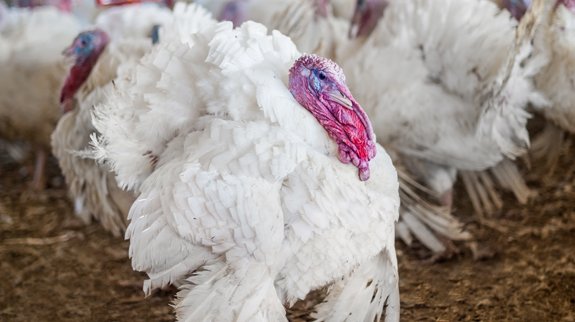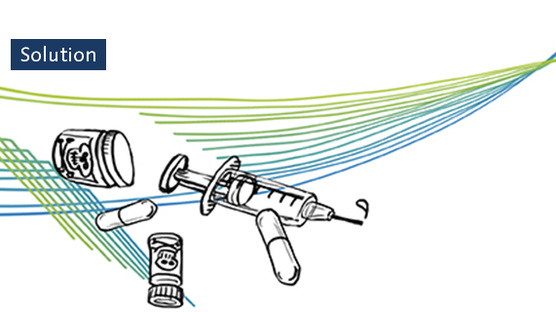
Published on Jan. 5, 2022
Preventing breast blisters and buttons
The incidence of breast blisters and buttons in turkey production represents a damaging issue for animal welfare and economic sustainability. At processing, blisters and buttons can cause downgrading, loss of meat, and increased processing time. What causes blisters and buttons and what can turkey growers do to recognize and prevent them?
What are breast blisters and buttons?
Breast buttons are skin lesions that appear to be due to contact irritation as a result of inflammation, by trauma or infection, of the sternal bursa along the keel bone of the turkey. It is usually seen in turkeys who spend most of their time lying down on their breast bone. The severity varies from mild to severe and can include feather loss and inflammation to extensive, fluid-filled blisters.
Key factors to consider
Important to consider in understanding this condition is that in the past 20 years, turkey genetics have progressed. Realistically, management should also reflect these changes. Turkey weights have increased by 1.6 kg in the last 5 years, leading to heavier turkeys that require excellent leg strength and management of leg issues when they arise. Additionally, because of the increase in popularity of antibiotic-free and organic production, the industry has reduced its use of antimicrobials that previously protected good gut health. In terms of animal husbandry, it has become harder and harder to find good labourers. Labor is more expensive and usually has less experience working with birds. Combined with aging barns and equipment, these factors work together to create more challenging conditions for turkeys to grow.
For blisters and buttons to develop, you need the bird to apply pressure on the breast and have the breast in contact with an irritating environment. Anything that increases the birds’ time spent on the ground, especially moist litter that can be a main irritant, will increase the prevalence of blisters and buttons. Lastly, feathering is a natural protection against an irritating environment. Feathering can be impacted by nutrition, temperature, humidity, and litter conditions.
What can be done to minimize the incidence?
Biosecurity
Biosecurity is a key area that can always be improved. Start with small and basic measures, like dedicated footwear, coveralls, and good barn entry segregations. Focus on eliminating darkling beetles, flies, wild birds, rodents, etc. Be sure to place fresh rodent bait in bait stations and apply insecticide.
Water Sanitation
In terms of water sanitation, there are numerous systems available. What is important is that the system you choose is reliable, consistent, shows good results and has good technical support. Technical support representatives should be there to help set up the system and troubleshoot any issues during the implementation phase.
Cleaning lines should be done twice: when birds are moved out and one to two days before new birds are placed in. There are two kinds of common deposits in waterlines: biofilm and mineral. You must use specific chemicals in order to remove the deposits. Use the right product, at the right rate and let it sit at least 24h or as per label before flushing.
Water sanitation is important as it increases gut health. It also reduces the “water” caused by flushing on litter. It also prevents multiple diseases such as Bordetella, ORT, and Newcastle Disease (NDV).
Vaccination
Vaccination improves gut health and reduces flushing. It also improves bird activity, leading to less time sitting on the floor. Growers should consider certain vaccines such as HE and cocci. Similar to water sanitation, without monitoring the results of vaccination, growers will not be able to track the most effective solutions for them. A local veterinarian should be consulted for assistance.
Nutrition
Proteins, vitamins and minerals all play a role in feathering, leg strength and gut health, which are all important to mitigate blisters. A problem you see at 10 weeks of age could be coming from an early incidence of poor diet. For more information, you can contact Hybrid Turkeys technical support team.
Litter Condition
Litter acts as a sponge, but it has limited moisture-holding capacity. If birds constantly add moisture to the sponge, the moisture builds up and can become extremely saturated and wet. Noticing early when the humidity in the barn is too high will help prevent litter from caking, which is the most effective method when maintaining litter conditions. How drinkers are managed can have a tremendous impact on the amount of water present in the barn. Be sure to have the appropriate type of drinkers for the age of the flock. It’s also important to have the appropriate drinker height, water pressure, with frequent movement of bell drinkers. Water lines should also be well maintained and not leaking.
If litter is already caked, you can apply top dressing, remove cakes, till the litter, and look at adapting your ventilation/heating. The higher your density, the less room for error there is when preventing excessive moisture. Furthermore, increased density can impact bird activity negatively. Both factors will increase blisters and buttons.
Ventilation/Temperature
Ventilation is important to help remove excess moisture from the barn. One of the most efficient methods for removing moisture in poultry barns is through negative pressure/minimum ventilation. Exhaust fans and inlets are designed to create a negative pressure in the barn, allowing the moisture to be removed (controlled), while at the same time conserving fuel. With proper minimum ventilation, cold air can mix with the warm moist air concentrated at the ceiling (warm air from birds and heaters will concentrate at the ceiling as warm air rises and cold air falls). When air is preheated and expanded to be able to carry moisture, it can then mix with the air near the floor, picking up moisture and removing it through the negative pressure fans.
Lighting
Daylength setting should be based on turkey-specific recommendations. Light intensity and period of light influences bird activity.
Light intensity
- 80-100 lux for the first 5-7 days
- Grow: 40 lux minimum
- Required for normal skeleton and feather growth
- Increases activity
Period of darkness
- Recommended: 6h continuous
- Required in order to let the birds sleep, otherwise, their melatonin levels will negatively impact their feed consumption
In summary, to prevent the incidence of breast blisters and buttons, growers must properly manage their barn environment, which contributes to good bird health. Eliminating breast blisters and buttons will lead to healthy, productive birds that reach their full potential.


